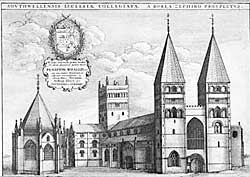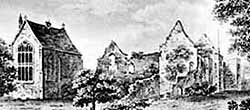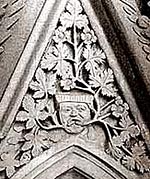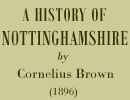< Previous | Contents | Next >
 Southwell Minster in the 1670s.
Southwell Minster in the 1670s.Influenced doubtless by Cranmer, whose native place is almost within sight of Southwell, the church was declared by Act of Parliament ‘the head mother church of the town and county of Nottingham’ (1543), and not only became refounded and re-endowed, but made the site of a bishopric. Dr. Cox, afterwards Bishop of Ely, was appointed to the new see; but for want of sufficient revenue the establishment was not completed. In the reign of Edward VI. the Chapter was dissolved, and the possessions alienated; but they were restored by Queen Mary ‘in as ample a manner as they had before been holden.’ Archbishop Heath, who had been instrumental in procuring for Southwell a restoration of the estates, was deprived of his see by Queen Elizabeth through his adherence to the Roman Catholic faith (1560), and his successors for sixteen years did not take much notice of the town. But in 1576 Archbishop Sandys manifested a great fondness for the palatial abode near the minster, and is said to have lived in it during the greater part of a long prelacy. He was a prominent figure in his day, having been one of the Commission by whom Mary Queen of Scots was tried and condemned. Fuller gives him a good character, stating in his own quaint way that he was ‘an excellent and painful preacher of a quiet and godly life, which increased in his old age, so that by a great and good stride, while he had one foot in the grave, he had the other in heaven.’ His beautiful monument in the minster is one of the most interesting objects for any visitor to inspect.
James I., travelling from Scotland to London to assume the reins of government, passed through the town in 1603, and expressed his admiration for the church as one which, in his opinion, could compare with any in the kingdom.
Of Charles I. and his visits to Southwell much might be said, but it will suffice to mention that it was here the unfortunate monarch, after negotiations with the Scots Commissioners, surrendered himself into their hands. On May 6, 1646, his Majesty arrived at the King’s Arms, now known as the Saracen’s Head, and having stayed awhile to take refreshment, was conducted to Kelham, near Newark, where the Scottish army lay encamped. It is to this circumstance that Bishop Selwyn, who spent a night at this historic inn in 1842, alludes in verses entitled ‘A Sleepless Night at Southwell:’
‘I cannot rest—for on the spot Where I have made my bed,
O’erwearied with the strife of state, A king bath laid his head.
‘Thy sacred head, ill-fated Charles,
Hath lain where now I lie,
And thou hast passed in Southwell Inn
As sleepless night as I.

The Bishop's Palace in the early 19th century. Much of the fabric dates from the 14th/15th centuries. The building on the left is the state chamber, the only part of the palace to have survived the Civil War intact.
Subsequently the town was occupied by Puritan troops, and it is said that the nave of the minster was used as a stable for their horses. The palace was damaged, and the unrestrained troopers wrought havoc at their own sweet will. ‘From this time,’ says Mr. Shilton, ‘ravage was the order of the day, and Cavaliers, Roundheads, and Covenanters alternately exercised their several abilities with such effect that when, soon after the surrender of Charles, an order was made for dismantling the palace very little was found undone.’ It is stated that a warrant was issued for taking down the ante-choir of the church, and such other parts of the fabric as might not be necessary for the use of the parish, but that the edifice was saved these threatened losses by the intervention of Mr. Cludd, a prominent Parliamentarian, who, on the alienation of the archbishop’s property, had purchased a good deal of it, and had taken up his residence in Norwood Park.
From this time forward the chief events may be summarized. In 1711, a violent storm of thunder and lightning caught the north spire, and occasioned the burning of part of the church. It became necessary to recast the bells, and this was done in 1721, as appears by the inscriptions. In 1801-1802 the spires on the western towers were removed, fears being entertained as to their safety and security.
From 1804 to 1807 Lord Byron’s mother resided at the Burgage Manor House; and it was here that the youthful poet came from Eton to spend his holidays. On a South-well play-bill, dated August 8, 1804, the play is announced as bespoke by ‘Mrs. and Lord Byron.’ Moore supplies us with many interesting details of his Southwell life, and an insight into the varied nature of his occupations in the cathedral town may be gleaned from one of Byron’s own letters, wherein he says: ‘I have been transporting a servant who cheated me, performing in private theatricals, publishing a volume of poems, making love, and taking physic.’ The volume of poems was a thin quarto of sixty-six pages, with the simple title of ‘Fugitive Pieces,’ and issued from the press of Messrs. S. and J. Ridge, of Newark, in November, 1806.
 The 'Green Man' in Southwell Minster chapter house.
The 'Green Man' in Southwell Minster chapter house.In 1805 a very interesting addition was made to the church in the brass eagle, now used as a reading-desk. It had been found in the bed of the lake at Newstead Abbey, and had passed into the hands of a dealer, from whom it was bought and given to the church by Sir Richard Kaye, Prebendary of Southwell, and Dean of Lincoln. About thirteen years ago vigorous steps were taken to create a new diocese, to consist of the counties of Nottingham and Derby, and to raise Southwell Minster to the dignity of the cathedral church. These efforts were happily successful, and the endowment having been secured by subscription, an Order in Council was issued on February 2, 1884, founding the bishopric, and the collegiate church of Southwell became the cathedral of the new diocese. The first Bishop nominated was the Right Rev. George Ridding, D.D., Head Master of Winchester College, who was consecrated on May 1, 1884. Thus through a long succession of years the old church of Southwell has been an important centre of Church life, and its noble fabric has been used and admired by numbers of eminent divines and statesmen, who have loved to worship within it. In the words of Bishop Selwyn,
‘And hence the daily choral song,
The Gospel’s hopes and fears,
Have sounded forth to Christian hearts,
Beyond a thousand years.’
We can only hope that it may long remain to have the ‘Gospel’s hopes and fears’ sounded to Christian hearts within its sacred walls, and that clothed in its new dignity it may have a future worthy of its historic greatness—a future of brightness and prosperity, and of ever-increasing influence for the good of the Church, and the welfare of the diocese of which it constitutes an ornament and a centre.
